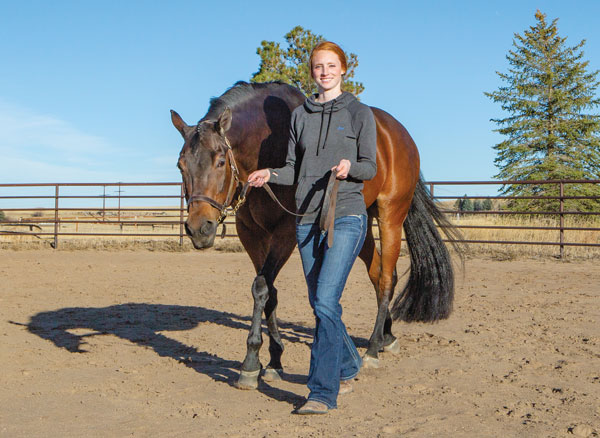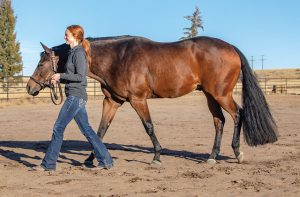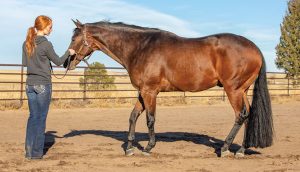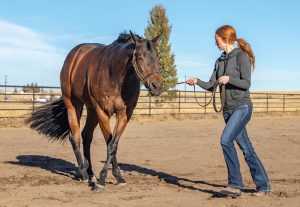
You’ve seen sleekly groomed western showmanship horses with expert skills move in sync with their handlers while outfitted in halters with shining silver. The horses stand at attention with their legs in perfect alignment. They walk, trot, pivot and stop with perfect cadence. Teaching your horse to move this way takes practice, but it can help you develop a partnership—one where you know your horse will cooperate no matter where you lead.
“Teaching a horse to respect his handler and perform certain maneuvers from the ground up is key,” says Gloude. “A confident, well-trained horse will exhibit good ground manners. He’ll allow the handler to control his every move. This control does not happen overnight. It could take months and some- times years. But once achieved, you will have earned a high level of respect from your horse.”

Walk This Way
SHOW-WORTHY MOVE: Your horse should walk next to you and move at the pace you decide. Make sure that your horse can walk in a straight line. Stand at your horse’s left side and extend your hand forward while applying pressure to the lead.
Your horse should move off freely when you ask and move straight forward in the direction you point. If your horse wants to bend away from the straight path, walk along a fence or alongside a ground pole to keep a straight line.
Next, increase your go-cue pressure, and as you start to jog, you should cue for the trot. If your horse resists this cue, don’t make eye contact.
Your horse may move to the side. Instead, keep your eyes forward and keep contact until your horse trots. Once he’s in the gait, keep moving, but make sure not to keep pulling. Releasing pressure serves as the reward for your horse picking up the trot.
AROUND THE BARN: You’ll want your horse to focus and move at your speed when you’re moving through a stall door or gate. It’s also important that your horse will walk straight past another horse when needed. Plus, if your horse can easily trot on command, your veterinarian will appreciate this skill during pre-purchase or lameness evaluations.
Stop and Pose
SHOW-WORTHY MOVE: When it’s time to stop, say “whoa” to alert the horse that he should stop in a straight line with his legs squarely beneath him. Once he’s stopped, turn to stand facing his left shoulder. Make sure you’re never directly in front of your horse to ensure that you can’t be run over.

To square your horse’s legs, move your right hand gently toward your horse’s right hind leg. Holding the lead rope while pointing your hand at the hoof that you want to move cues your horse with halter pressure.
Once the right hind foot is positioned in line with the left rear, praise him. Your horse will gain confidence from the praise and will learn your intricate cues. Make sure your cues are consistent each time. Ideally, your horse will stop and set up easily with little to no movement from your hand. Work up to this with repetition.
The perfect set-up is not trainable overnight. It may take years to develop this as one of your western showmanship skills. Once the horse is trained with consistency, proficiency will follow.
AROUND THE BARN: You’ll need your horse to stop and be patient as you open a gate or do any small chore. Your horse will need to stop and set up nicely for farrier appointments and to stand balanced as you pick his hooves.
Round and Round
SHOW-WORTHY MOVE: In a show, your horse must keep his right hind foot still during the pivot turn. Your horse will need to turn 360 degrees in most show patterns.

To cue for this, turn your body to face your horse’s jaw. Your horse will move his shoulders away from your body, pivoting to the right. As the horse starts to grasp the concept, ask for a sharper turn. Lift your right hand to shift the horse’s weight to his hind end.
AROUND THE BARN: Knowing that you can pivot your horse will help you make tight turns in a wash rack or anywhere you may need to turn sharply.
“A handler that fully develops each of these skills in their horse will have a horse that is rewarded by the judges as well as appreciated at home,” says Gloude.
Thanks to Lexi Radic and Incredibly Natural for assistance with these photos.
This article on western showmanship skills appeared in the February 2020 issue of Horse Illustrated magazine. Click here to subscribe!





